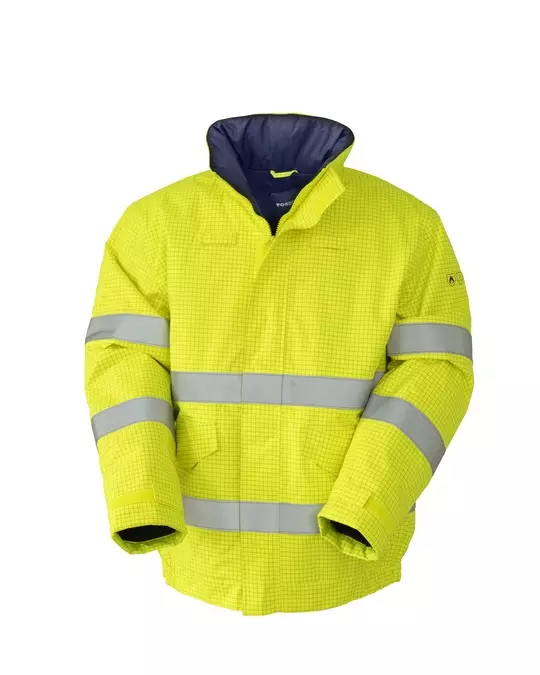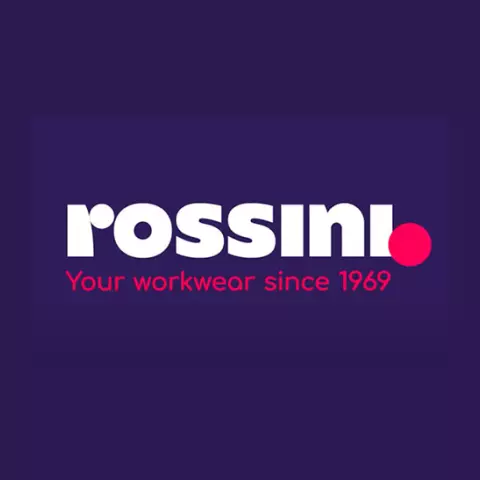Rossini Multinorm Hi-Vis Bomber, Yellow
Rossini
visit storeProduct description
Professional safety jacket combining high visibility features with flame-retardant protection. This padded jacket features multiple secure closure points including a central zip with Velcro cover and adjustable hood. Enhanced with practical elements like a radio hook, data register label, and multiple pockets, it's designed for both safety and functionality.
Product Features:
- High neck design with adjustable drawstring hood
- Central zip closure with Velcro-secured cover
- Radio hook on chest and internal data register label
- Multiple pockets including internal welt pocket and two large flap-covered lower pockets
- Adjustable Velcro cuffs with inner elastic wrist protection
- Reflective stripes on front and back
Technical Details:
- Exterior: Oxford 300D PVC-coated fabric (98% polyester, 2% antistatic)
- Interior: 100% cotton flame retardant lining
- Padding: 100% polyester flame retardant material
Determines visibility, safety compliance, and professional appearance, with options ranging from high-visibility safety colors to standard work tones.
An integrated hood provides essential head protection from the elements, keeping you dry and focused on the job.
Full-length sleeves provide essential protection and warmth, keeping your arms shielded from the elements and workplace hazards.
The bomber style offers a comfortable, waist-length fit for unrestricted movement, keeping you agile and focused on the job.
Defines pocket types and locations, such as chest, ID, or zipper pockets, providing organized storage and quick access to tools, phones, and work essentials.
Determines how the jacket fits your body, affecting comfort, mobility, and layering options during work activities.
Adjustable Velcro cuffs provide a secure, custom fit, sealing out elements and debris to keep you comfortable and protected.
Elastic cuffs provide a secure, comfortable fit, sealing out elements and ensuring unrestricted movement for optimal performance.
The design and structure of the neckline area, affecting protection from elements, professional appearance, and comfort around the neck and shoulders.
The method used to fasten the jacket or vest, affecting ease of use, security, and weather protection during work activities.
- Water Resistance
- Cold Protective
- Chemical Resistance
- Heat & Flame Resistance
- High Visibility
- Electrical Protection
- Machine Washable
Request a free sample
Test first and buy later. Visit any product page to request your free sample.
Standards and labels
EN 1149-5:2018 is a European standard that specifies the requirements for electrostatic dissipative (ESD) gloves. This standard defines performance requirements for material, design, and testing of ESD gloves. The gloves must be able to effectively discharge static electricity and protect the wearer from ESD. Testing includes measuring the surface resistance of the glove material and electrical resistance of the glove. Pass/fail results are based on the gloves meeting or not meeting the specified requirements.
Test results
Material Performance TestedThe standard EN 1149-5:2018 pertains to the performance of materials with regard to their electrostatic properties, specifically testing for the charge decay characteristics. The test result Tested signifies that the material has been evaluated according to the specified methods and met the defined criteria for electrostatic properties under this standard. To determine this result, a set of specific test methods is deployed to assess the decay of electrostatic charge from the surface of the material. The test involves subjecting the material to an electrostatic charge and then measuring the rate and manner in which this charge dissipates. This ensures that materials such as those used in protective clothing are safe for use in environments where electrostatic discharge could pose a hazard, such as in certain industrial or medical settings where flammable substances are present. For procurement professionals, understanding that a product has been tested and meets EN 1149-5:2018 standards is crucial as it ensures the product's safety and suitability in environments susceptible to electrostatic risks.
Test results
Reflective Strip Area Grade 3The EN ISO 20471:2013 standard specifies the requirements for high-visibility clothing, with a specific focus on the reflective strip area, a crucial element for ensuring visibility in low-light conditions. A test result achieving Grade 3 indicates the highest level of reflectivity performance in this standard, ensuring optimal visibility and safety for the wearer in various lighting conditions. In grade 3 products reflective tape is 0.20 m2 and fluorescent material is 0.8 m2.The test methodology involves assessing the amount and quality of retroreflective material on garments. This is quantified under precise conditions to ensure that the reflective strips meet stringent visibility requirements even from significant distances or in poor lighting conditions. Garments that meet Grade 3 requirements are suitable for use in high-risk environments where being seen by others is crucial for safety, such as road construction sites, airport ground operations, and other scenarios with high vehicular traffic or complex visual backgrounds.
EN 13688:2013 is a European standard that specifies the performance requirements for protective clothing. The standard includes requirements for safety, comfort, and durability, as well as tests for determining these properties. Protective clothing includes items like coveralls, aprons, and gloves that are worn to protect the wearer from hazards. Possible test results include resistance to chemicals, heat, abrasion and tearing, as well as breathability and comfort. The clothing can be tested under different conditions to check if it meets the standard's requirements.
EN 343 is a European standard for protective clothing against bad weather. It says clothes must be waterproof, breathable, and not let water in. It's used to protect workers in different industries like construction and transportation. Tests must show the clothing meets these standards.
Test results
Breathability Class 1In the standard EN 343:2019, Breathability Class 1 specifies the lowest (RET > 40) level of breathability for protective clothing against rain. This class is designated for garments that have a tested breathability value which meets the minimum requirement for water vapor resistance according to the specifications laid out in the standard. The practical implication of a Class 1 result is that the garment allows a limited amount of water vapor to pass through, making it suitable for less intensive or shorter duration activities in wet conditions.
Downpour XEN 343:2019 is a standard that delineates requirements and assessment methodologies for protective clothing, specifically tailored to garments intended to offer protection against precipitation and wet conditions.Result X signifies that the garment's performance in resisting water penetration during simulated downpours has not been specified or assessed. The practical implications of this result are notable, as it indicates that the garment may not offer adequate protection against heavy rain and prolonged exposure to wet conditions, potentially compromising wearer comfort and safety, particularly in outdoor work environments where protection from inclement weather is paramount.
Waterproofness Class 3EN 343:2019 is designed to ensure that protective clothing provides specific levels of protection against rain, considering its waterproof capabilities. Class 3 in this standard represents the highest level of waterproofness, indicating that the garment successfully resists a high volume of water penetration (more than 13000 Pascal Pressure units after pre-treatment). The test method used involves simulating wet weather conditions, where the fabric is exposed to varying degrees of water projections and pressures to evaluate its resistance. Fabrics that achieve Class 3 certification tend to have undergone rigorous testing such as high-pressure spray tests or being subject to a controlled volume of water for a defined period. These are particularly relevant for professional use in extremely wet environments where the highest level of water resistance is necessary, providing critical protection in conditions from heavy rain to immersion scenarios. This high classification impacts the practical usability of such clothing in industries such as outdoor work, marine activities, or emergency services where maximum protection from water exposure is critical for safety and performance.
EN 13034:2005 is a European standard that outlines the requirements and test methods for Type 6 protective clothing designed to provide protection against liquid chemical hazards. It specifies criteria for the fabric's resistance to penetration by liquid chemicals and establishes guidelines for the overall design and construction of the garments. The amendment A1:2009 introduces updates and refinements to enhance the performance and reliability of Type 6 protective clothing, ensuring improved protection for workers exposed to liquid chemical splashes and sprays. These standards are essential in industries where workers are at risk of encountering liquid chemical hazards, ensuring their safety and well-being.
Test results
Liquid Chemical Protection Type 6 PBEN 13034:2005+A1:2009 specifies the performance requirements for protective clothing that offers limited protection against liquid chemicals, identified specifically as Type 6 PB (partial body protection). The 'Type 6 PB' designation implies that the protective garment has been tested and confirmed to provide effective defense against light spray and minor splashes of liquid chemicals, but only for parts of the body such as aprons, sleeves, or boots rather than full body suits. This standard tests the fabric's barrier effectiveness by applying a defined volume of liquid to the garment and assessing any penetration or repellence under controlled laboratory conditions. Garments achieving Type 6 PB classification are crucial for tasks in industries like chemical processing or handling where full body coverage is unnecessary, thereby offering flexibility and targeted protection, reducing the risk of chemical exposure to critical areas of the body.
CE Marking is a label that shows a product meets certain safety and environmental standards set by the European Union. To get the CE Marking, a company must test and certify their product meets these standards. CE Marking is required for many products sold in the EU, including electronics, machinery, toys and medical devices. It helps ensure that products are safe for consumers and the environment, and allows for easy trade within the EU.
PPE stands for "personal protective equipment." PPE Category 2 refers to equipment that is more complex, and has a higher level of risk. Examples of PPE Category 2 include safety helmets, ear protection, and fall arrest equipment. In Europe, PPE Category 2 must meet certain safety standards set by the European Union, which means that it must be designed and manufactured to protect the user without causing harm. Companies that make or sell PPE must prove that it meets these standards. They also must have a quality management system in place and have to be audited regularly by a notified body.
Rossini delivery terms
Free delivery when you order more than 300,00 € from Rossini
Supplier shipping fee 5,00 €
Brand minimum 0,00 €
129,10 €
Shipping fee is 5,00 € for orders under 300,00 €
Sold in units of one piece
Need larger quantities?
Other products you may like
Recently viewed
Need help?
Get help from our experts
Other products you may like
Similar products you may like
Autonomous sourcing platform
The most efficient way to source and order supplies for your operations
Sourcing
Ordering
List products you’re looking for and we’ll find the best products and prices for you – all for free.
Need help?
Get help from our experts



